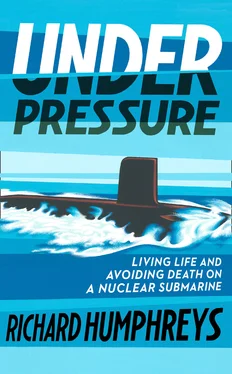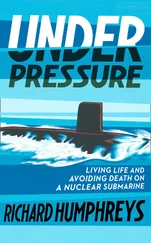SINS (ship’s inertial navigation system): internal navigation system, fitted with gyroscopes, accelerometers and velocity meters, that constantly updates submarine’s position.
SSN (nuclear-powered attack submarine): nuclear submarine not carrying nuclear weapons, known as hunter-killers for ferocious pursuit of Soviet submarines. HMS Conqueror , which sank the Argentinian General Belgrano , was an SSN. They were armed with torpedoes and anti-ship missiles.
SSBN (nuclear-powered ballistic missile-carrying submarine): see ‘Resolution’ class.
tactical systems team: part of warfare team, providing complete tactical picture for captain and XO using information from sonar via sound room and periscopes if at PD, through use of target motion analysis to calculate course, speed and range of any given contact.
thermocline: temperature differentials within body of water due to seasonal variation, local conditions or latitude and longitude that give submarines acoustic blanket to hide in from sonar.
Trident: current British nuclear missile system that began replacing Polaris in 1994.
warfare team: team responsible for fighting the submarine under leadership of XO, who in turn reports to captain.
work-up: sea trials in front of onboard teaching staff ensuring crew are capable of taking submarine on deterrent patrol.
wrecking team: engineering team looking after forward part of submarine and watch-keeping at systems console in control room.
Ranks and roles
AB (able seaman): Royal Navy rating in seaman branch, above ordinary seaman and below leading seaman.
afterplanesman: controls afterplanes at bow of submarine, tilting them back to surface, forward to dive. Also steers submarine to left (port) and right (starboard).
captain: commanding officer of submarine, also referred to as ‘skipper’, ‘the man’ or ‘God’.
chief ops: chief petty officer in charge of sound room as well as sonar ratings and any other senior rates who are sonar specialists. A highly experienced sonar operator, usually excels at quizzes.
chief wrecker: chief engineer who operates and watch-keeps at systems console, leading a team of junior rate wreckers maintaining engineering systems at front end of boat.
coxswain: ship’s senior rating, normally with rank of chief petty officer or warrant officer.
CPO (chief petty officer): senior non-commissioned officer in most navies, rank between petty officer and warrant officer.
foreplanesman: controls operation of foreplanes from the control room. Works in conjunction with afterplanesman to maintain correct pitch and depth of submarine, crucial when at PD.
junior rates: heartbeat of submarine, keeping her alive and buzzing every day. Responsible for storing ship, cleaning and scrubbing out for inspections, watchkeeping duties, and also for most of drinking and entertainment while at sea.
Lt Cdr (lieutenant commander): commissioned officer in Royal Navy, above a lieutenant and below a commander. Heads of departments on submarine were all lieutenant commanders, as was XO.
leading radio operator: leading hand working in wireless office monitoring signals from Command Centre at Northwood. Equivalent rank to corporal in Army.
leading seaman: either a sonar operator or tactical systems operative, a key member of attack team.
leading steward: personal steward to captain, also likely to do a turn on ship control steering submarine.
master-at-arms (MAA): see coxswain.
MEM (marine engineering mechanic): driving force on boat, ensuring all mechanical and life services from nuclear reactor to air purification and laundry tick over. Most importantly, keeps toilets flushing.
MEO (marine engineering officer): senior engineering officer tasked with safe working and operation of nuclear reactor and all other engineering systems. Reports to captain. Usually at rank of Lt Cdr. Mine was cerebral and friendly, and played a mean Spanish guitar.
NO (navigating officer): seaman officer in charge of navigation, holds charts and maps of patrol area in a locked room on 1 Deck. Member of warfare team. Reports to XO. At rank of lieutenant. Known as Vasco or pilot.
OOW (officer of the watch): seaman officer, captain’s representative while watch-keeping at sea, preserving safety of submarine in all aspects, especially avoiding grounding and collision. Accountable to captain for safety of entire submarine while on watch.
QM (quartermaster): in charge of external security of submarine, managing ship’s crew inventory so no one gets on board without his knowledge. Also helps with logistics of storing ship.
RPO (reactor panel operator): monitors reactor and associated electrical and propulsion systems from manoeuvring room.
senior rates: non-commissioned officers, either petty officers or chief petty officers.
surgeon lieutenant: doctor on board, hides in sick bay armed with paracetamol. Unlikely to display standard bedside manner. At rank of lieutenant. Also does turn at ship control on patrol.
TASO (tactics and sensors officer): seaman officer, part of warfare team. Reports to XO. At rank of lieutenant.
WEM (weapons engineering mechanic): junior rating looking after maintenance of torpedoes and electrical systems of sonar and other computer systems.
WEO (weapons engineering officer): in charge of loading, maintenance and firing of nuclear weapons and torpedoes. Reports to captain. Usually at rank of Lt Cdr.
XO (executive officer): the Jimmy, Number 1 or second-in-command of submarine. Like captain, will have passed Perisher course. Overall in charge of warfare team. Reports to captain. Usually at rank of Lt Cdr.
The Cold War, deep under the North Atlantic. Probably, but who knows? I certainly don’t. Right now we could be anywhere. All I can hear are whales communicating with each other, a haunting sound that’s somewhat tragic in delivery, like a loved one bereft for eternity.
Theoretically, we are 15 minutes from the start of Armageddon. That’s the time it would take between us receiving the firing signal from the prime minister and the nuclear warheads being launched. I’m on patrol – submarine patrol – aboard a sizeable chunk of Britain’s nuclear deterrent. We are the hidden. We see and hear everything, but only ever listen – we never communicate. A highly trained, motivated, elite team of submariners, we’re the best in the business. It’s the middle of the night in the control room, all the dials bathed in soft red lighting. I haven’t slept well for days; I’ve got bad skin and my body clock has gone haywire. And then it happens.
A distant noise. Panic sets in. Undetected by our sonar, it’s as if the intruder has come from nowhere. The crew freeze, the next 30 seconds drip by … What is it, friend or foe? Have we been detected and compromised? Suddenly, the tell-tale sound of a submarine’s propeller screams over the top of us no more than 50 feet away. All hell breaks loose. I literally dive full-length into a seat on the fire-control system, as we scramble around looking for answers. We assign the rogue sub a target number and track it as it passes to the stern of us, then, phantom-like, gradually fades away to the east, never to be heard from again.
That was close, way too close. The captain made the call – correctly, of course – that it was making far too much noise to have detected us. But even so, most of the crew on watch when it happened are now nervously fidgeting, thinking to themselves: How did we miss it? There’s a lot resting on our – mostly very young – shoulders. We can never be detected or compromised. Nor can we seek and destroy. We can only evade. Our job is to hide the bomber, this monster of the deep.
Читать дальше












